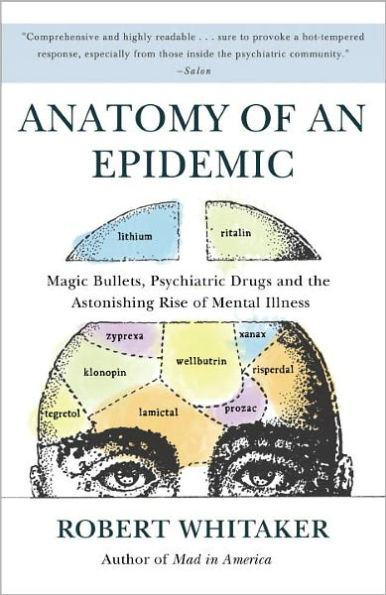Read an Excerpt
1
A Modern Plague
“That is the essence of science: ask an impertinent question, and you are on the way to a pertinent answer.” —Jacob Bronowski (1973)
This is the story of a medical puzzle. The puzzle is of a most curious sort, and yet one that we as a society desperately need to solve, for it tells of a hidden epidemic that is diminishing the lives of millions of Americans, including a rapidly increasing number of children. The epidemic has grown in size and scope over the past five decades, and now disables 850 adults and 250 children every day. And those startling numbers only hint at the true scope of this modern plague, for they are only a count of those who have become so ill that their families or caregivers are newly eligible to receive a disability check from the federal government.
Now, here is the puzzle.
As a society, we have come to understand that psychiatry has made great progress in treating mental illness over the past fifty years. Scientists are uncovering the biological causes of mental disorders, and pharmaceutical companies have developed a number of effective medications for these conditions. This story has been told in newspapers, magazines, and books, and evidence of our societal belief in it can be found in our spending habits. In 2007, we spent $25 billion on anti-depressants and antipsychotics, and to put that figure in perspective, that was more than the gross domestic product of Cameroon, a nation of 18 million people.
In 1999, U.S. surgeon general David Satcher neatly summed up this story of scientific progress in a 458- page report titled Mental Health. The modern era of psychiatry, he explained, could be said to have begun in 1954. Prior to that time, psychiatry lacked treatments that could “prevent patients from becoming chronically ill.” But then Thorazine was introduced. This was the first drug that was a specific antidote to a mental disorder—it was an antipsychotic medication—and it kicked off a psychopharmacological revolution. Soon antidepressants and antianxiety agents were discovered, and as a result, today we enjoy “a variety of treatments of well documented efficacy for the array of clearly defined mental and behavioral disorders that occur across the life span,” Satcher wrote. The introduction of Prozac and other “ second- generation” psychiatric drugs, the surgeon general added, was “stoked by advances in both neurosciences and molecular biology” and represented yet another leap forward in the treatment of mental disorders.
Medical students training to be psychiatrists read about this history in their textbooks, and the public reads about it in popular accounts of the field. Thorazine, wrote University of Toronto professor Edward Shorter, in his 1997 book, A History of Psychiatry, “initiated a revolution in psychiatry, comparable to the introduction of penicillin in general medicine.” That was the start of the “psychopharmacology era,” and today we can rest assured that science has proved that the drugs in psychiatry’s medicine cabinet are beneficial. “We have very effective and safe treatments for a broad array of psychiatric disorders,” Richard Friedman, director of the psychopharmacology clinic at Weill Cornell Medical College, informed readers of the New York Times on June 19, 2007. Three days later, the Boston Globe, in an editorial titled “When Kids Need Meds,” echoed this sentiment: “The development of powerful drugs has revolutionized the treatment of mental illness.”
Psychiatrists working in countries around the world also understand this to be true. At the 161st annual meeting of the American Psychiatric Association, which was held in May 2008 in Washington, D.C., nearly half of the twenty thousand psychiatrists who attended were foreigners. The hallways were filled with chatter about schizophrenia, bipolar illness, depression, panic disorder, attention deficit/hyperactivity disorder, and a host of other conditions described in the APA’s Diagnostic and Statistical Manual of Mental Disorders,and over the course of five days, most of the lectures, workshops, and symposiums told of advances in the field. “We have come a long way in understanding psychiatric disorders, and our knowledge continues to expand,” APA president Carolyn Robinowitz told the audience in her opening- day address. “Our work saves and improves so many lives.”
But here is the conundrum. Given this great advance in care, we should expect that the number of disabled mentally ill in the United States, on a per-capita basis, would have declined over the past fifty years. We should also expect that the number of disabled mentally ill, on a per-capita basis, would have declined since the arrival in 1988 of Prozac and the other second-generation psychiatric drugs. We should see a two- step drop in disability rates. Instead, as the psychopharmacology revolution has unfolded, the number of disabled mentally ill in the United States has skyrocketed. Moreover, this increase in the number of disabled mentally ill has accelerated further since the introduction of Prozac and the other secondgeneration psychiatric drugs. Most disturbing of all, this modernday plague has now spread to the nation’s children.
The disability numbers, in turn, lead to a much larger question. Why are so many Americans today, while they may not be disabled by mental illness, nevertheless plagued by chronic mental problems—by recurrent depression, by bipolar symptoms, and by crippling anxiety? If we have treatments that effectively address these disorders, why has mental illness become an ever- greater health problem in the United States?



